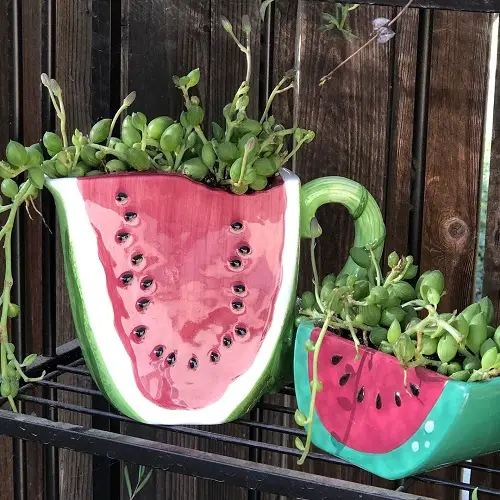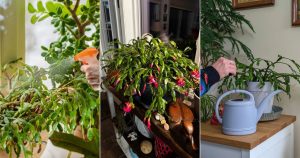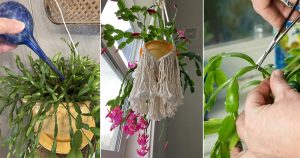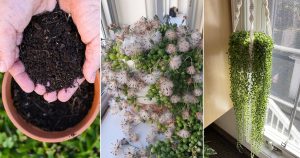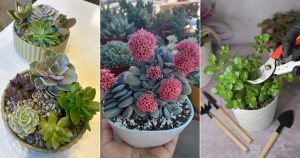Want to amaze your pals with a tiny necklace-like succulent? Use these String of Watermelon plant care and growing tips to show off your thriving plant!
If you love plants but can’t seem to find the space for them, the String of Watermelon, also popular as String of Melons or Senecio herreianus, is a beautiful trailing succulent that can fit into small spaces. And the best part? The unique pattern on the leaves resembles miniature watermelons, which everyone just loves!
String of Watermelon Plant Profile
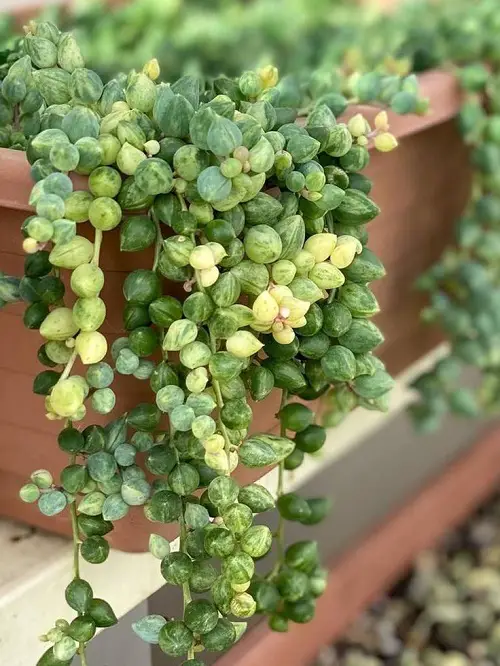
The String of Watermelon is a succulent plant from the Asteraceae family that calls South Africa its region of origin, but don’t you worry if you don’t happen to live there; this trailing succulent finds comfort in hanging baskets worldwide. As a matter of fact, a fully matured plant can dangle down several feet.
Going into detail on the individual aspects of the plant, the crystal-like or pea-like green beads or leaves steal the spotlight and they are what give it its common names like “String of Beads” or “String of Watermelon.” These succulent beads are puffy and round and have a pattern that reminds many of the stripes of a watermelon. This pattern is pronounced much more when they’re slightly stressed and take on a light purplish tone.
The blooms look quite alien, emerging in a tower of small, fluffy white flowers with a cinnamon-like scent that perfectly contrasts the greenish beads.
Botanical Name: Curio herreanus
String of Watermelon Propagation
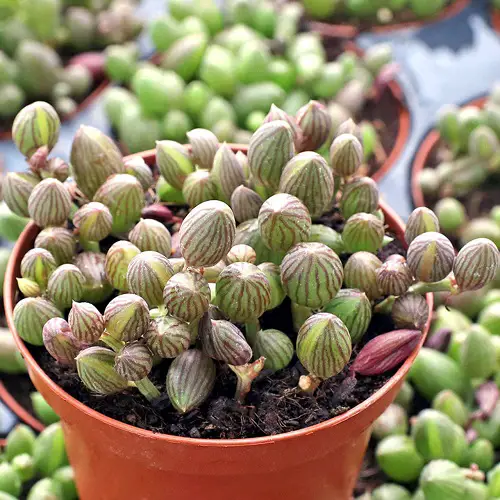
Now that you have seen the plant, don’t you want to own one? Proudly boast about it among your gardening pals? If so, try growing it with stem cuttings!
Stem cutting is the easiest and most commonly used method, and hence, it is your best choice for growing a thriving plant. The following are the steps to propagate the string of watermelon through stem cuttings:
Prepare Materials
It’s better to get everything ready beforehand. The items you’ll need are a pair of sharp and clean scissors or pruning shears, a small pot, succulent or cactus potting mix, and rooting hormone (optional).
Cutting
Since plants grown from cuttings are clones of the mother plant, select a healthy, long stem from your String of Watermelon plant. Using the scissors or shears, cut a section that’s a few inches long. Ensure that there are multiple “beads” or leaves on the stem cutting.
Let It Callus
To reduce the risk of rot, place the String of Watermelon cutting in a shaded, dry area for a day or two. This, in gardening terms, is called callusing, and it allows the cut end to dry out.
Planting
Get your hands dirty by filling the pot with the succulent or cactus mix. Insert the callused end of the stem cutting into the soil, making sure that a few beads are above the soil surface as that is vital for the survival of the plant.
Watering
Lightly water the soil, ensuring it’s damp but not soggy. Over the next few weeks, continue watering but only sparingly, allowing the soil to dry out between each watering session.
Location
Sunlight is necessary for the survival of any plant, but to bring out the best of this succulent, place the pot in a location with bright, indirect light.
Root Development
A few weeks time is required for the development of the roots. The tug test can be performed to see if your plant is growing as required, you can lightly tug on the stem, and if you feel resistance, it likely means the roots have anchored themselves into the soil.
String of Watermelon Growing Requirements
Sunlight
If you are growing your String of Watermelon within your humble abode, find a location that receives bright, indirect light. A windowsill with translucent curtains or a spot a bit farther away from a bright window will do just fine.
For outside, the conditions may be a bit more harsh, so ensure that the plant is shaded or semi-shaded area. Direct sunlight, especially during noon, can scorch the leaves, taking away its wow factor.
Soil
A well-draining soil mix is essential. Since String of Watermelon is a succulent, succulent or cactus potting mixes are the best choice. These mixes prevent water from sitting around the roots, which can lead to root rot. If you wish to make a potting yourself, you can do so by adding 2 parts of coarse sand or perlite along with 1 part of compost or garden soil and another of peat moss or coconut coir.
Watering
As mentioned before, the string of watermelon does not like a ton of water, so make sure to only water it sparingly when then the top layer of soil feels dry to the touch. Overwatering can lead to root rot or invite pests and infections.
Tip: It’s better if your plant is underwatered than overwatered The beads/leaves of the plant store water, giving it the ability to withstand drought-like conditions.
Temperature
String of Watermelon prefers temperatures between 60°F to 75°F (15°C to 24°C). It does not tolerate either of the extremes—too cold or too hot. You should protect your plant at temperatures below 50F as it is frost sensitive, bringing them in during winter months can help. Whereas during the hottest part of the day, shielding them from direct sunlight is a must as the leaves may scorch due to intense heat.
Humidity
String of Watermelon thrives in a moderately humid environment, with ideal levels between 40-50%. If the humidity is too low, the leaves may start to shrivel or curl. One way to increase humidity is to mist the plant regularly or place a humidifier nearby.
String of Watermelon Care
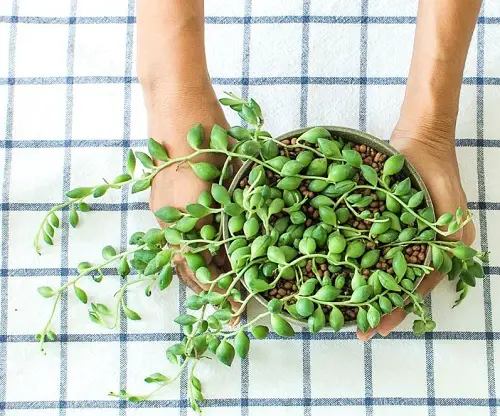
Fertilizer
String of Watermelon does not need constant fertilization, but once a month during the growing season, which is typically spring through early fall, will help the plant grow better. Using a balanced, water-soluble fertilizer with a low nitrogen content can work well. Remember to mix the fertilizer at half or quarter strength of the recommended dosage to avoid over-fertilization.
Pests
- Mealybugs: These small, cotton-like insects often hide in leaf axils or crevices. Rubbing alcohol is their kryptonite, so dab them with cotton soaked in it to remove them. If you do not have access to rubbing alcohol, insecticidal soap will do the same.
- Aphids: Tiny, soft-bodied insects that cluster on new growth. You can shoo them away with a strong spray of water or use a neem oil spray.
- Spider Mites: These can cause stippling on a String of Watermelon leaves and produce fine webs. They thrive in dry and arid conditions; therefore, regularly misting the plant can help prevent them. If an infestation occurs, rinse the plant with water or use insecticidal soap.
Diseases
- Root Rot: Root rot is caused by overwatering and poorly-draining soil. Prevent this disease by using a well-draining potting mix and allowing the soil to dry out between waterings. Remember, overwatering is a big no in the case of string of watermelon!
- Fungal Infections: You can keep the plant dry and provide good air circulation to minimize the risk of fungal infections on this beautiful succulent.

